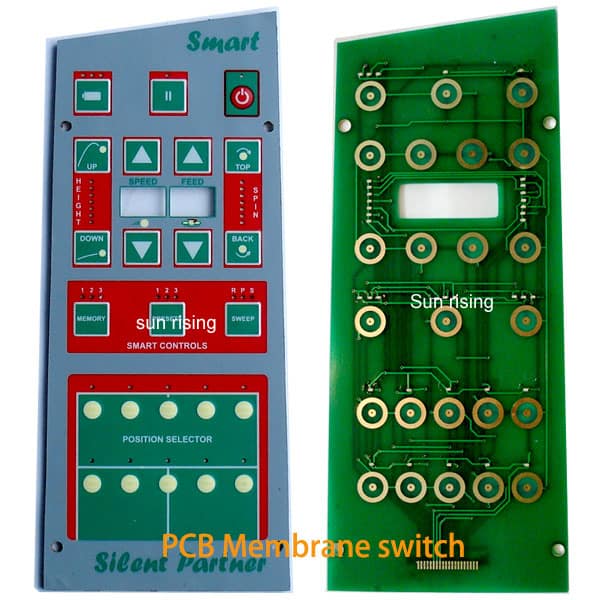How Membrane Switches Are Used to Enhance Safety and Functionality in Industrial Equipment
How Membrane Switches Are Used to Enhance Safety and Functionality in Industrial Equipment
Blog Article
Why Membrane Layer Switches Are Important for Resilient Control Solution
Membrane buttons play a crucial duty in ensuring the sturdiness and dependability of control systems throughout numerous sectors. Their unique construction allows them to endure challenging environmental elements such as humidity, temperature extremes, and physical wear. This durability not only prolongs the life expectancy of the systems they offer but also decreases upkeep needs. As we discover the diverse advantages of membrane switches, it becomes evident that their significance transcends mere capability, influencing user experience and operational efficiency. What further effects do these features hold for the future of control system layout?
Summary of Membrane Switches
Membrane switches are flexible and reputable components frequently used in numerous digital control systems. The graphic overlay supplies both functional and aesthetic design, while the spacer layer guarantees that the switches are activated only when pressed.
Membrane layer buttons are frequently favored in applications calling for a small and lightweight design, making them perfect for handheld devices, medical equipment, and industrial equipment. They can be tailored to fulfill specific user requirements and can integrate different functions such as backlighting, responsive responses, and numerous shades. Furthermore, membrane switches are resistant to dust, moisture, and impurities, making them ideal for atmospheres where longevity is essential.
Advantages of Longevity
In many applications, the toughness of membrane layer switches deals substantial benefits that boost their total performance and integrity. These switches are designed to stand up to rough environments, making them perfect for usage in requiring problems such as high moisture, extreme temperatures, and exposure to chemicals. Their robust building and construction aids to protect against damages from physical effect, ensuring long-lasting functionality and reducing the requirement for regular replacements.
Furthermore, membrane buttons are resistant to damage, which is crucial in applications where regular communication happens. This toughness converts to reduce maintenance expenses, as companies gain from reduced downtime and less service disturbances. In addition, the encapsulated layout of membrane layer switches over secures interior elements from dust and moisture access, more adding to their life expectancy.
Another benefit is their capability to preserve consistent efficiency gradually. With a high tolerance for mechanical stress, these buttons protect their tactile responses and electric integrity, making certain customer fulfillment. Eventually, the durability of membrane layer changes not just enhances operational effectiveness however also cultivates confidence in their integrity, making them a favored selection for control systems throughout various fields.
Applications in Different Industries
Durable control systems utilizing membrane buttons find substantial applications across an array of industries, each gaining from the distinct qualities these buttons supply. In the clinical sector, membrane switches are critical for gadgets such as person screens and analysis equipment, where dependability and convenience of cleaning are extremely important. Their resistance to moisture and pollutants guarantees they maintain performance in clean and sterile atmospheres.
The vehicle industry leverages membrane switches for dashboard controls and infotainment systems, where they offer sleek, low-profile interfaces that improve individual experience. These buttons are likewise developed to endure severe conditions, consisting of direct exposure to severe temperatures and vibrations.
In commercial setups, membrane switches are commonly used in equipment control board, providing tactile responses and longevity essential for high-usage applications. Their capability to withstand chemicals makes them suitable for making settings where spills and pollutants are frequent.

Customer electronic devices, such as kitchen devices and remotes, likewise make use of membrane switches for their adaptability and cost-effectiveness. Overall, the flexibility and robust nature of membrane layer changes make them indispensable throughout various fields, guaranteeing reliable procedure and long life in control systems.
Layout and Aesthetic Appeal
While capability is vital, the style and aesthetic charm of control systems equipped with membrane layer switches play an essential function in individual interaction and total experience (membrane switch). The visual style of these buttons can substantially influence customer assumption and interaction. A well-designed membrane layer switch improves the beauty of the tool, making it more appealing to users and fostering a connection in between the customer and the item
Membrane switches offer a large amount of versatility in design, permitting manufacturers to personalize graphics, shades, and appearances to align with brand identity and product aesthetics. Using lively shades and distinct patterns can attract attention, while tactile feedback can strengthen the individual's communication with the tool. In addition, the capacity to incorporate LED indicators and backlighting into the membrane switch design offers both practical and aesthetic benefits, improving exposure and functionality in different atmospheres.

Enhancing User Experience

In addition, membrane buttons can be personalized to incorporate visual interfaces, boosting functionality by offering info in a clear and instinctive way (membrane switch). This modification can include symbols, labels, and shade coding that guide customers with facility performances with convenience. Furthermore, their convenience enables assimilation in various atmospheres, ensuring constant efficiency whether website here in industrial equipment or consumer electronics
The sturdiness of membrane switches also plays a vital duty in user experience. By standing up to rough conditions and prolonged usage, these buttons decrease the possibility of system failures, hence advertising dependability and user confidence. Eventually, the critical use membrane changes not just boosts capability but also substantially improves customer communication with control systems, making them an indispensable part in modern layout.
Final Thought

Report this page